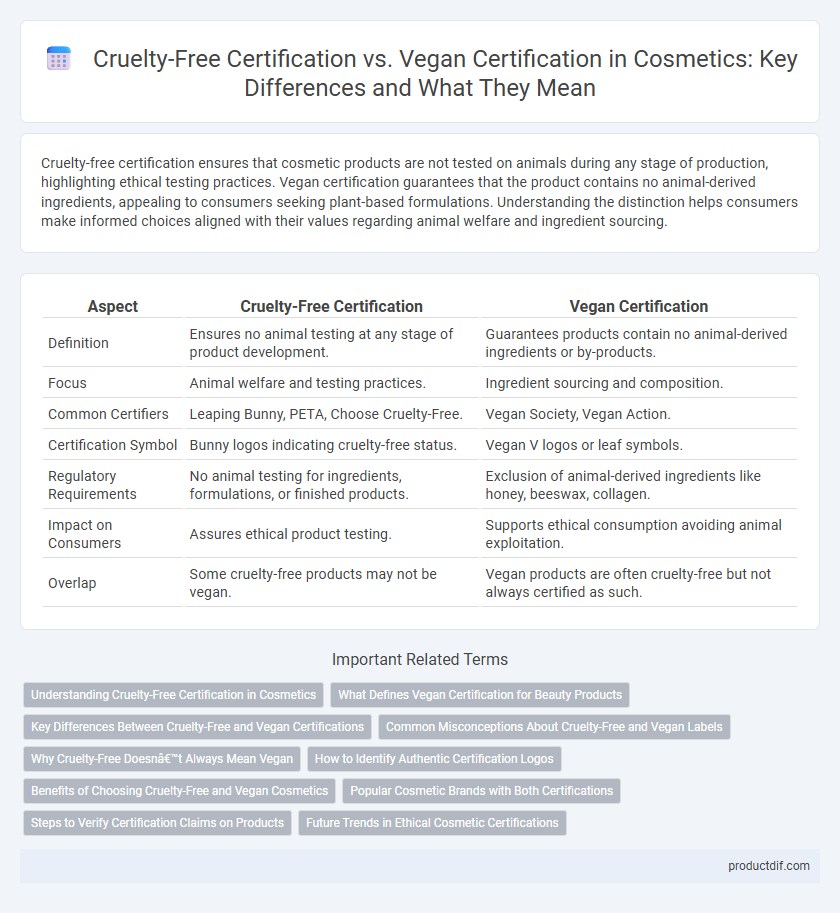Cruelty-free certification ensures that cosmetic products are not tested on animals during any stage of production, highlighting ethical testing practices. Vegan certification guarantees that the product contains no animal-derived ingredients, appealing to consumers seeking plant-based formulations. Understanding the distinction helps consumers make informed choices aligned with their values regarding animal welfare and ingredient sourcing.
Table of Comparison
| Aspect | Cruelty-Free Certification | Vegan Certification |
|---|---|---|
| Definition | Ensures no animal testing at any stage of product development. | Guarantees products contain no animal-derived ingredients or by-products. |
| Focus | Animal welfare and testing practices. | Ingredient sourcing and composition. |
| Common Certifiers | Leaping Bunny, PETA, Choose Cruelty-Free. | Vegan Society, Vegan Action. |
| Certification Symbol | Bunny logos indicating cruelty-free status. | Vegan V logos or leaf symbols. |
| Regulatory Requirements | No animal testing for ingredients, formulations, or finished products. | Exclusion of animal-derived ingredients like honey, beeswax, collagen. |
| Impact on Consumers | Assures ethical product testing. | Supports ethical consumption avoiding animal exploitation. |
| Overlap | Some cruelty-free products may not be vegan. | Vegan products are often cruelty-free but not always certified as such. |
Understanding Cruelty-Free Certification in Cosmetics
Cruelty-free certification in cosmetics ensures that products and their ingredients are not tested on animals at any stage of development, reflecting a commitment to ethical standards in product safety. This certification is verified by organizations such as Leaping Bunny and PETA, providing consumers with trustworthy assurance that no animal suffering was involved. Understanding the distinction between cruelty-free and vegan certifications highlights that cruelty-free focuses solely on animal testing policies, while vegan certification pertains to the absence of animal-derived ingredients.
What Defines Vegan Certification for Beauty Products
Vegan certification for beauty products ensures formulations exclude all animal-derived ingredients such as beeswax, lanolin, and carmine, while also prohibiting animal testing in line with cruelty-free standards. This certification requires thorough supply chain audits and ingredient verification to guarantee that no animal exploitation occurs at any production stage. Consumers seeking ethical cosmetics prioritize vegan certification for transparency on ingredient origin and animal welfare commitment.
Key Differences Between Cruelty-Free and Vegan Certifications
Cruelty-free certification ensures that products and their ingredients are not tested on animals at any stage of development, while vegan certification guarantees the absence of animal-derived ingredients in the final product. Brands can be cruelty-free but still use animal by-products, highlighting the fundamental distinction between ethical treatment of animals and ingredient composition. Understanding these certifications helps consumers make informed choices aligned with their values regarding animal welfare and ingredient sourcing.
Common Misconceptions About Cruelty-Free and Vegan Labels
Cruelty-free certification ensures that no animal testing was conducted during any phase of a product's development, whereas vegan certification guarantees the absence of animal-derived ingredients in the formulation. A common misconception is that cruelty-free products must be vegan, but many cruelty-free items still contain animal by-products like beeswax or lanolin. Consumers often mistake vegan labels as an indicator of ethical testing practices, when in reality, vegan certification does not address animal testing protocols.
Why Cruelty-Free Doesn’t Always Mean Vegan
Cruelty-free certification guarantees that no animal testing was conducted during product development, but it doesn't ensure the absence of animal-derived ingredients such as beeswax, lanolin, or collagen. Vegan certification specifically verifies that a product contains no animal by-products or derivatives, emphasizing ingredient sourcing rather than testing methods. Understanding this distinction is crucial for consumers seeking truly animal-friendly cosmetics, as a cruelty-free label alone may include non-vegan components.
How to Identify Authentic Certification Logos
Authentic cruelty-free certification logos, such as Leaping Bunny or PETA's cruelty-free bunny, guarantee that no animal testing occurred at any stage of product development, verified through rigorous audits and supplier checks. Vegan certification logos, like Vegan Society or Certified Vegan, confirm that products contain no animal-derived ingredients and have been independently reviewed for compliance. To identify genuine certifications, examine official registries, verify logo usage against certifying body guidelines, and look for batch-specific codes or QR scans that link directly to certification status.
Benefits of Choosing Cruelty-Free and Vegan Cosmetics
Choosing cruelty-free and vegan cosmetics ensures products are not tested on animals and contain no animal-derived ingredients, promoting ethical beauty standards. These certifications often lead to safer, hypoallergenic formulations that reduce the risk of allergic reactions and skin irritation. Consumers benefit from supporting sustainable brands committed to environmental conservation and animal welfare, aligning with conscious lifestyle choices.
Popular Cosmetic Brands with Both Certifications
Popular cosmetic brands with both Cruelty-Free and Vegan certifications include e.l.f. Cosmetics, Pacifica Beauty, and Milk Makeup, which appeal to ethically conscious consumers. These certifications assure that products are not tested on animals and contain no animal-derived ingredients, meeting stringent standards set by organizations like Leaping Bunny and Vegan Society. Emphasizing dual certification helps brands build trust and loyalty among customers seeking transparent, ethical beauty options.
Steps to Verify Certification Claims on Products
To verify cruelty-free certification claims, consumers should check for official logos from recognized organizations such as Leaping Bunny or PETA, and review the brand's transparency regarding third-party audits. For vegan certification, verifying the presence of certifications like Vegan Society or Certified Vegan labels ensures products contain no animal-derived ingredients. Cross-referencing ingredients lists against reputable databases and examining updated certification status on the certifiers' websites further confirms the authenticity of both cruelty-free and vegan claims.
Future Trends in Ethical Cosmetic Certifications
The future of ethical cosmetic certifications is increasingly shaped by growing consumer demand for transparency and sustainability, with Cruelty-Free Certification emphasizing animal welfare and Vegan Certification ensuring the absence of animal-derived ingredients. Innovations in biotechnology and plant-based formulations are driving the expansion of Vegan Cosmetic products, while blockchain technology enhances traceability and authenticity in certification processes. Emerging dual certifications combining cruelty-free and vegan standards are set to lead market differentiation and consumer trust in the evolving ethical beauty industry.
Cruelty-Free Certification vs Vegan Certification Infographic

 productdif.com
productdif.com